
Source | Nature Reviews Materials, Research Insights
Original Article | https://doi.org/10.1038/s41578-023-00643-0
01
Background Introduction
Harvesting energy from the environment provides a pathway for obtaining green energy, capable of powering various applications that do not rely on the grid, such as personal thermal management and self-powered electronic devices.Environmental moisture in the air is an ubiquitous natural energy reservoir, sparking widespread interest in developing water-induced energy harvesting technologies. Evaporation power generation is an emerging method to obtain energy through natural processes rather than mechanical work. However, the natural evaporation of water is limited by the long-term reliance on liquid water sources and is affected by climatic conditions. Furthermore, the use of water vapor adsorbents to artificially regulate environmental moisture between gas and adsorbed states provides a controllable and sustainable method for obtaining green energy from the environment. Adsorbents facilitate the reversible phase change of water, known as water adsorption and desorption, spontaneously converting gaseous water from unsaturated moisture with relative humidity (RH) below 100% into adsorbed water. The diversity of adsorbents with varying water affinity endows them with high climate adaptability, theoretically enabling water phase transitions based on adsorbents to occur anytime and anywhere.
Traditionally, the adsorption-based cooling water machines or dehumidifiers rely on additional heat sources to drive the regeneration of adsorbents, leading to the conventional view that water adsorption technology is an air process or energy storage technology rather than an energy harvesting technology. Exciting progress in adsorption-induced power generation and desorption cooling indicates that moisture-sorption-based energy harvesting (MSEH) can maintain prolonged operating times and can be driven by environmental energy from humidity gradients or diurnal humidity fluctuations without additional energy consumption, enriching the content and functionality of moisture absorption technologies. Unlike traditional closed-loop water adsorption heating and cooling systems, MSEH systems require vacuum maintenance and expensive valves and pumps, while MSEH systems directly exchange water with environmental moisture, making the technology passive and flexible. With the rapid development of various types and functions of MSEH technology, it is increasingly recognized that environmental moisture is not only a working medium for energy conversion and storage but also a widely available green energy source in certain cases. According to the International Energy Agency (IEA) report, nearly half of global energy demand is for heating and cooling, indicating significant energy-saving potential in the processes of heat collection, conversion, storage, and utilization.
02
Highlights of Achievements
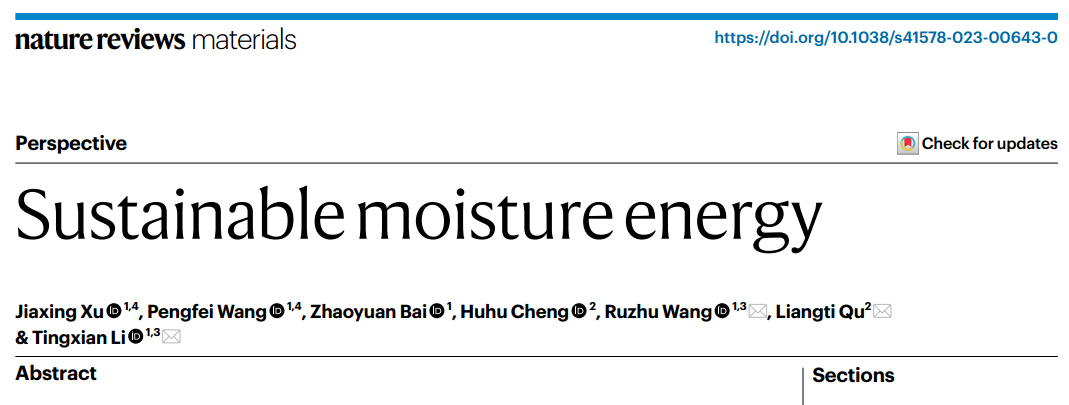
Recently, a review on humidity-induced sustainable energy harvesting technology (MSEH) based on water vapor adsorption has been conducted by Li Tingxian from Shanghai Jiao Tong University, Qu Liangti from Tsinghua University, and Wang Ruzhu from Shanghai Jiao Tong University. MSEH is a promising strategy to obtain heat, cold, and electricity from ubiquitous moisture anytime and anywhere. Advances in moisture-absorbing materials have facilitated the development of sustainable moisture energy. However, MSEH technology faces challenges such as low energy productivity and limited understanding of its working mechanisms and thermodynamic analyses. This perspective article focuses on an in-depth understanding of the potential mechanisms and thermodynamic limitations of sustainable moisture energy. The article first introduces the working principles of MSEH for heating, cooling, and power generation, summarizing the latest research progress on adsorbents. Then, we discuss the thermodynamic limitations and assess the global potential of sustainable moisture energy. We outline the challenges of future moisture absorption kinetics and propose technical directions for accelerating ordered cross-scale energy transfer and mass transfer of water adsorption-desorption. Finally, we summarize future research areas of next-generation high-performance MSEH adsorbents with higher water absorption, adjustable hydrophilicity, and faster water absorption. The research findings were published in “Sustainable Moisture Energy” in Nature Reviews Materials.
03
Graphic Introduction
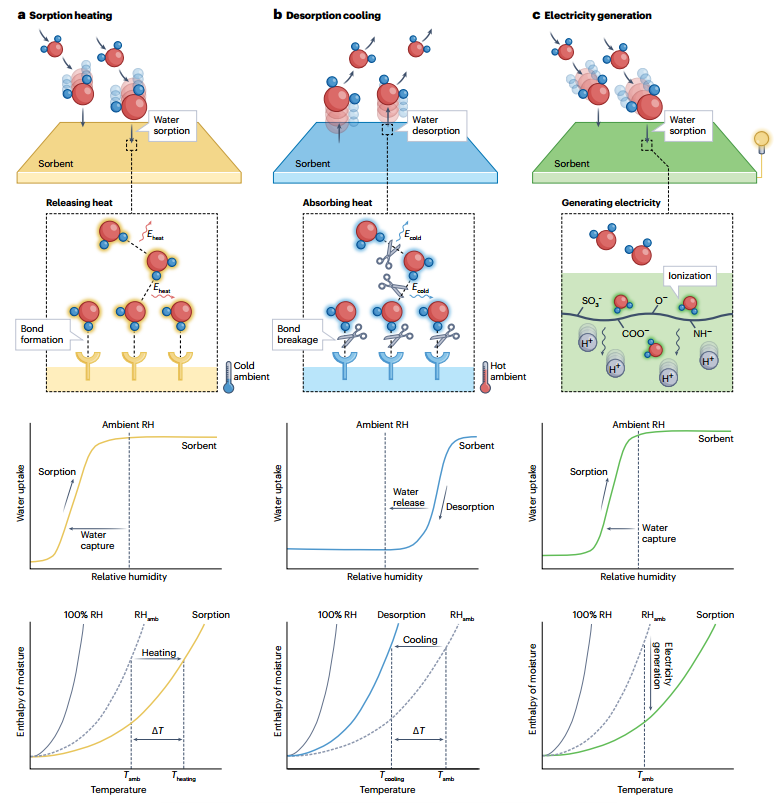
Figure 1. Schematic diagram of the working principles of heating, cooling, and power generation based on humidity adsorption technology. a, Adsorbents capture water molecules from the ambient air, releasing adsorption heat to generate heating effects. b, Water molecules desorb from the adsorbent and are released into the air, absorbing heat from the environment to create cooling effects. c, Water molecules in the ambient humidity contact the functional groups of the adsorbent, leading to the desorption and directional diffusion of protons or ions, generating electrical effects.
Working Principle of Energy Collection from Humid Air
Water vapor adsorption materials can induce the transition of water molecules in the air between gaseous and adsorbed states, a phase change process accompanied by significant enthalpy and entropy changes, thus releasing or absorbing large amounts of energy. Developing and utilizing this energy enables spontaneous acquisition of heat, cold, and electricity from humid air (Figure 1). Among them, the heat generation from adsorption occurs due to the formation of bonds or van der Waals forces between the adsorbent and water molecules during the water vapor adsorption process, thus releasing substantial heat. Correspondingly, the desorption of water vapor is accompanied by bond breaking, generating an equal endothermic effect. However, in the past few decades, reports on desorption-induced cooling have been scarce, primarily due to traditional adsorbent materials requiring high regeneration temperatures, making it difficult to drive desorption spontaneously from low temperature or low humidity, hence unable to absorb heat from the environment for cooling effects. In recent years, with the development of various weakly hygroscopic materials, it has become possible for the adsorbed water to be released into the air at lower temperatures for cooling while spontaneously capturing water vapor from the air. Therefore, compared to traditional evaporation cooling technologies, the desorption cooling technology based on adsorbent materials has the advantage of water conservation. Moisture power generation has been discovered in some nanoadsorbents with hydrophilic functional groups, one possible working mechanism can be likened to photovoltaic power generation, where the interaction between water molecules and hydrophilic functional groups on the adsorbent induces charged ions to dissociate and migrate from the adsorption interface to the interior, thus generating voltage and current effects.
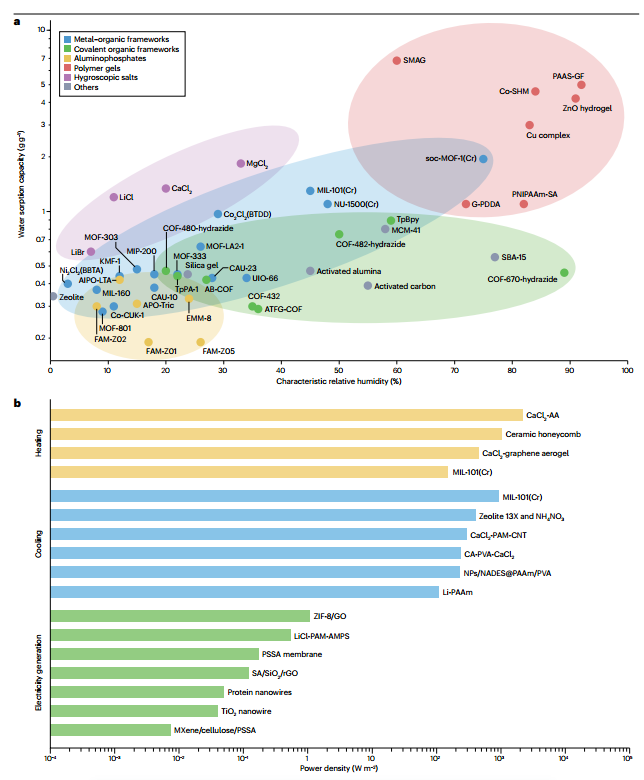
Figure 2. Thermodynamic characteristics and potential of humidity-induced energy harvesting technology. a, From the perspective of potential energy, the strength of the water evaporation potential of unsaturated humid air and the adsorption potential of the adsorbent determines the thermodynamic direction of water vapor adsorption (heat generation, electricity generation) or desorption (cooling). b, The enthalpy-humidity diagram of air shows ideal adiabatic adsorption heat generation, adiabatic desorption cooling, and isothermal moisture power generation thermodynamic processes. c, From the perspective of Gibbs free energy changes, it illustrates the thermodynamic cycles of humidity-induced energy harvesting driven by humidity differences and temperature differences.
Water Vapor Adsorption Materials
In recent years, the emergence of new water vapor adsorption materials has propelled the development of humidity-induced energy harvesting technology. The key to MSEH lies in selecting suitable adsorption materials. The amount of water vapor adsorbed at different humidity levels is one of the key performance parameters of materials, determining the energy density and duration of MSEH. Currently, various new water vapor adsorption materials have been developed, such as Metal-Organic Frameworks (MOFs), Covalent Organic Frameworks (COFs), polymer gels, and hygroscopic salt composites, whose water vapor adsorption performance determines the energy production capacity of MSEH. These materials exhibit different water vapor adsorption performances at varying characteristic relative humidities (the humidity corresponding to half of the saturated adsorption capacity) (Figure 2a). Under low humidity conditions, hygroscopic salt materials still have a certain advantage in adsorption capacity, but they generally face challenges such as caking, corrosion, and solution leakage. Encapsulating hygroscopic salts in highly porous or expandable matrices can address the caking issue; however, the long-term stability and reliability in practical applications remain to be explored. At high humidity levels, gel materials perform excellently, while MOF and COF materials are developing rapidly, with continually improving performance, where high adsorption capacity at low humidity is currently the focus of breakthroughs. With the development of MSEH materials and devices, their power density has significantly increased, but there is still considerable potential for further development (Figure 2b). Understanding the complex processes of water and energy transfer is key to improving kinetics. The design of different adsorbent materials, components, and devices has a significant impact on the final power density, with the kinetics of the adsorbent material being one of the core factors. In summary, the water absorption performance of adsorbents plays a crucial role in the operational performance of MSEH, where the adsorption capacity determines the energy density, and the adsorption kinetics of the adsorbents determine the power density. Further breakthroughs in the energy production capacity of MSEH technology require an in-depth understanding of the thermodynamics and kinetics of water vapor adsorption to guide the thermal design and development of the next-generation high-performance adsorbents.
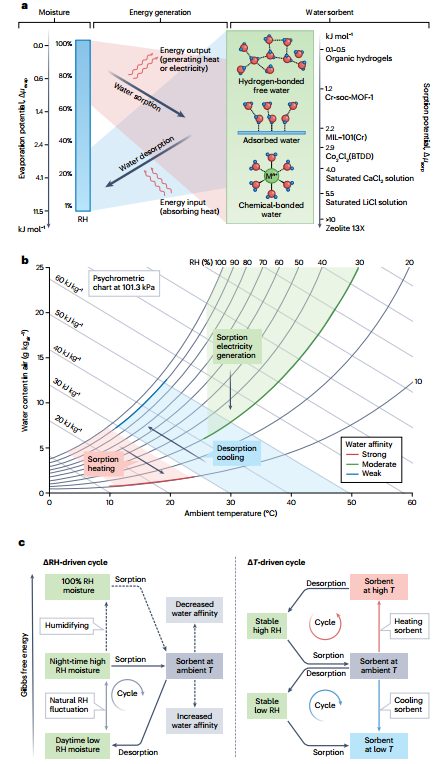
Figure 3. Thermodynamic characteristics and potential of humidity-induced energy harvesting technology. a, From the perspective of potential energy, the strength of the water evaporation potential of unsaturated humid air and the adsorption potential of the adsorbent determines the thermodynamic direction of water vapor adsorption (heat generation, electricity generation) or desorption (cooling). b, The enthalpy-humidity diagram of air shows ideal adiabatic adsorption heat generation, adiabatic desorption cooling, and isothermal moisture power generation thermodynamic processes. c, From the perspective of Gibbs free energy changes, it illustrates the thermodynamic cycles of humidity-induced energy harvesting driven by humidity differences and temperature differences.
Thermodynamic Analysis and Global Potential of Humidity-Induced Sustainable Energy
The article deeply explores the energy conversion mechanisms, thermodynamic processes, and thermodynamic cycles of acquiring energy from humidity (Figure 3). First, it introduces the energy changes during the processes of water vapor adsorption and desorption, including changes in enthalpy, Gibbs free energy, and chemical potential, and analyzes the energy conversion efficiency based on the first and second laws. It points out that energy harvesting technology based on water vapor adsorption is limited by thermodynamics and proposes methods to improve energy collection efficiency, such as optimizing the water vapor affinity of adsorption materials, designing smart adjustable moisture adsorption materials, and utilizing natural humidity fluctuations or external cold/heat sources to drive regeneration cycles. Through thermodynamic analysis, the article first calculates and evaluates the energy acquisition potential in different climatic regions globally, finding that although humid air is a low-grade energy source, with reasonable material design and device construction, efficient thermodynamic processes can be achieved, and considerable energy output can still be obtained by fully tapping its thermodynamic potential (Figure 4).
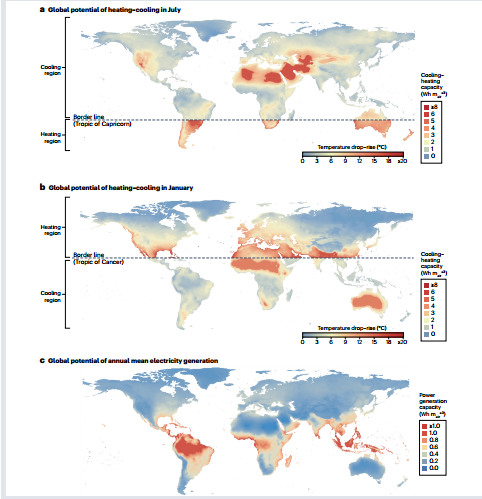
Figure 4. Global production potential of energy acquisition from humid air. a, Global heat production potential in July (Southern Hemisphere), cooling production potential (Northern Hemisphere). b, Global heat production potential in January (Northern Hemisphere), cooling production potential (Southern Hemisphere). c, Global electricity production potential.
Kinetic Analysis of Humidity-Induced Sustainable Energy.
The article particularly emphasizes: Thermodynamics determines the energy density and energy quality of MSEH technology, while kinetics determines the power density of energy production. By analyzing the complex adsorption kinetics processes, the article clarifies that the water vapor adsorption process involves a series of sequential transport processes of moisture and energy between the external adsorbent, between adsorbent particles, within mesopores/micropores of the adsorbent, and at the adsorption sites (Figure 5). Factors influencing adsorption kinetics include mass transfer coefficients, porosity, tortuosity, thickness, and activation energy. To address the challenge of slow kinetics, the article looks forward to utilizing ordered cross-scale energy transfer and mass transfer to accelerate water adsorption-desorption and provides specific potential technical strategies to improve power density. For example, at the device scale, designing efficient heat exchangers, airflow channels, electrodes, and interfacial areas. At the macro-pore scale, constructing hierarchical pore structures with ordered transport channels can utilize self-growth, templating methods, and 3D printing to prepare porous structured adsorbents, and two-dimensional materials can be used as precursors to construct functional, ordered, and stable porous structures. At the nanoscale, new materials need to be designed from the source or the composition or properties of precursors need to be adjusted to improve micropore performance. At the molecular scale, suitable hydrophilic adsorption sites need to be introduced, and the density of adsorption sites needs to be increased to reduce activation energy and enhance reaction rates. Furthermore, stimuli-responsive or humidity-responsive characteristics can be introduced, allowing the hydrophilicity of adsorbents to be intelligently adjusted based on environmental or user needs.
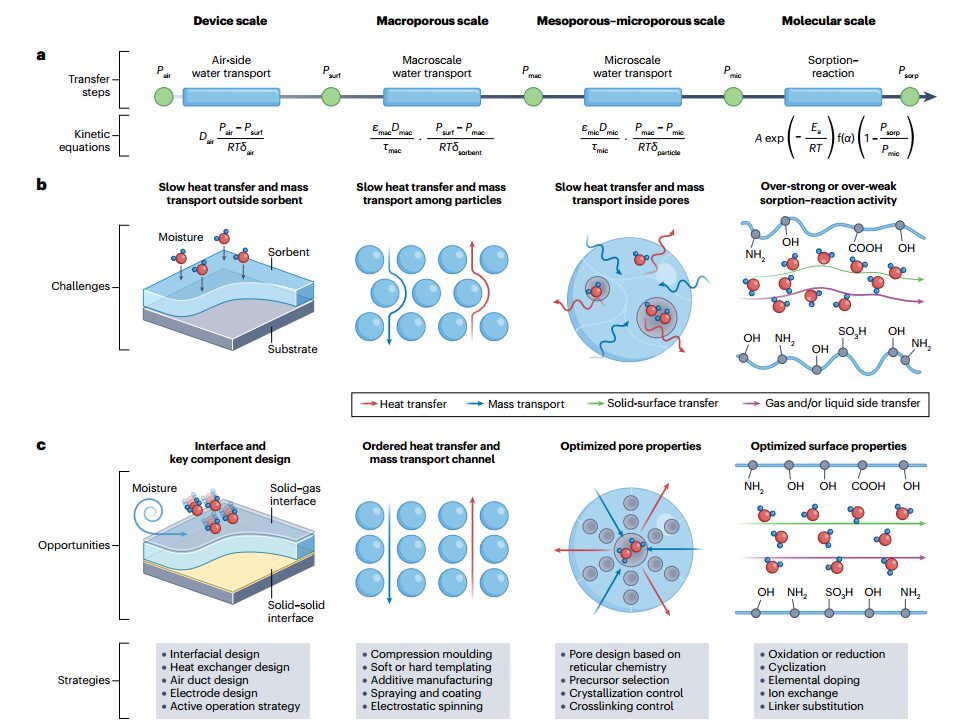
Figure 5. Heat and mass transfer characteristics, challenges, and opportunities of humidity-induced energy harvesting technology. a, Characteristics of sequential transport of materials and energy during the humidity-induced energy harvesting process: device scale transport – macro-pore scale transport – micropore/mesopore scale transport – molecular scale adsorption/reaction. b, Challenges of slow heat and mass transfer rates: air-side transport resistance – inter-particle transport resistance – intra-pore transport resistance – adsorption/reaction resistance. c, Research opportunities and potential strategies to improve the kinetic characteristics of humidity-induced energy harvesting at different scales.
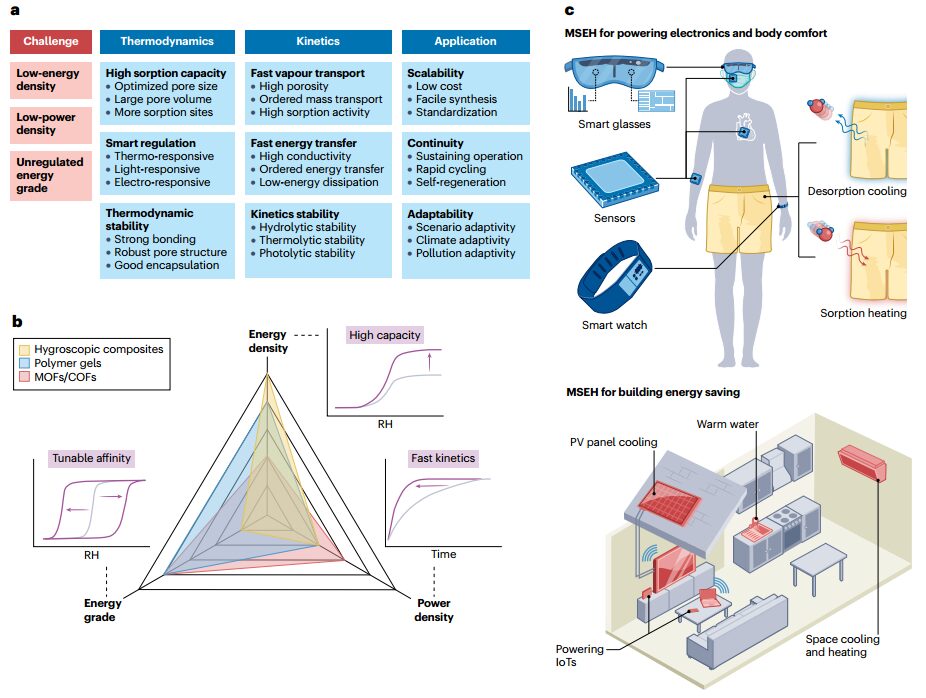
Figure 6. Outlook for the design of next-generation water vapor adsorption materials and future practical application scenarios. a, Outlook on the research directions and methods for high-performance water vapor adsorption materials. b, Three main evaluation dimensions of water vapor adsorption materials: adsorption capacity, hydrophilicity, and adsorption kinetics. c, Two typical application scenarios of MSEH in personal and building energy management.
The article concludes with a comprehensive outlook on the future development directions of MSEH technology, including the development of new adsorption energy materials, the construction of intelligent energy harvesting units/devices/systems, and the utilization of renewable heat sources and humidity fluctuations to drive cycles. The article points out that to achieve high energy and power density in energy harvesting, it is necessary to develop new water vapor adsorption materials with high adsorption capacity, adjustable hydrophilicity, rapid kinetics, and good stability. To fully exploit the thermodynamic and kinetic potential, it is essential to optimize the design of MSEH devices and systems, reduce energy losses, and improve energy conversion efficiency. The article proposes strategies such as utilizing heat recovery, material recovery, and staged energy utilization, combined with natural humidity fluctuations or externally renewable cold/heat sources to drive cycles, as well as developing intelligent control and adjustment mechanisms. Finally, the article envisions that MSEH technology can provide a comfortable thermal environment for humans and buildings, reliable power sources for self-powered electronic devices, and innovative solutions for other related fields (Figure 6). Harvesting energy from humid air is expected to become a widely available, low-carbon, and environmentally friendly energy harvesting technology, providing new solutions for distributed energy needs and sustainable energy transition.
 First Author—Xu Jiaxing Postdoctoral researcher at Shanghai Jiao Tong University, School of Mechanical and Power Engineering (co-supervisor: Li Tingxian), selected for the National Postdoctoral Innovation Talent Program, mainly engaged in research on adsorption-based air water harvesting and thermal storage technologies, with 8 SCI papers published as the first author (including co-authored) in internationally renowned journals such as Nature Reviews Materials, Energy & Environmental Science, Nature Communications (2), Angewandte Chemie-International Edition, and ACS Central Science, and 8 authorized/public patents.
First Author—Xu Jiaxing Postdoctoral researcher at Shanghai Jiao Tong University, School of Mechanical and Power Engineering (co-supervisor: Li Tingxian), selected for the National Postdoctoral Innovation Talent Program, mainly engaged in research on adsorption-based air water harvesting and thermal storage technologies, with 8 SCI papers published as the first author (including co-authored) in internationally renowned journals such as Nature Reviews Materials, Energy & Environmental Science, Nature Communications (2), Angewandte Chemie-International Edition, and ACS Central Science, and 8 authorized/public patents.
 Co-First Author—Wang Pengfei PhD student at Shanghai Jiao Tong University, School of Mechanical and Power Engineering (supervisor: Li Tingxian). Mainly engaged in research on adsorption-based air water harvesting and water-vapor power generation, with multiple papers published as the first author (including co-authored) in international journals such as Nature Reviews Materials, Nature Water, Matter, and Cell Reports Physical Science.
Co-First Author—Wang Pengfei PhD student at Shanghai Jiao Tong University, School of Mechanical and Power Engineering (supervisor: Li Tingxian). Mainly engaged in research on adsorption-based air water harvesting and water-vapor power generation, with multiple papers published as the first author (including co-authored) in international journals such as Nature Reviews Materials, Nature Water, Matter, and Cell Reports Physical Science.
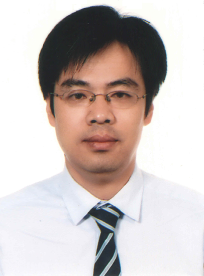 Corresponding Author—Li Tingxian Researcher at Shanghai Jiao Tong University, School of Mechanical and Power Engineering, recipient of the National Outstanding Youth Science Fund, listed among the top 2% of scientists globally. Long-term engaged in interdisciplinary research on engineering thermophysical issues in energy-saving and energy storage, covering research on solar cooling/heating/air water harvesting, high-density thermal energy storage, and energy quality regulation. In recent years, he has published a series of papers in international journals such as Nature Reviews Materials, Nature Energy, Nature Water, Nature Communications (3), Energy & Environmental Science, Advanced Materials, Angewandte Chemie-International Edition, ACS Energy Letters, Matter, and Progress in Energy & Combustion Science. His research achievements have received multiple awards, including the First Prize of the Shanghai Natural Science Award (first winner), Second Prize of the Shanghai Science and Technology Progress Award (fifth winner), Second Prize of the Technical Invention Award from the China Energy Conservation Association (third winner), and various other awards; he has applied for/authorized over 40 national invention patents, some of which have been industrially applied.
Corresponding Author—Li Tingxian Researcher at Shanghai Jiao Tong University, School of Mechanical and Power Engineering, recipient of the National Outstanding Youth Science Fund, listed among the top 2% of scientists globally. Long-term engaged in interdisciplinary research on engineering thermophysical issues in energy-saving and energy storage, covering research on solar cooling/heating/air water harvesting, high-density thermal energy storage, and energy quality regulation. In recent years, he has published a series of papers in international journals such as Nature Reviews Materials, Nature Energy, Nature Water, Nature Communications (3), Energy & Environmental Science, Advanced Materials, Angewandte Chemie-International Edition, ACS Energy Letters, Matter, and Progress in Energy & Combustion Science. His research achievements have received multiple awards, including the First Prize of the Shanghai Natural Science Award (first winner), Second Prize of the Shanghai Science and Technology Progress Award (fifth winner), Second Prize of the Technical Invention Award from the China Energy Conservation Association (third winner), and various other awards; he has applied for/authorized over 40 national invention patents, some of which have been industrially applied.
 Co-Corresponding Author—Qu Liangti Professor at the Department of Chemistry, Tsinghua University, recipient of the National Outstanding Youth Science Fund and the “Changjiang Scholar” Distinguished Professor of the Ministry of Education. He has published over 300 papers in important international journals such as Science, Nature, Nature Nanotechnology, Chem. Rev., Angew. Chem. Int. Ed., Adv. Mater., and J. Am. Chem. Soc., with over 20,000 citations. He has been invited to write review papers in Nature Reviews Materials, Accounts of Chemical Research, Chemical Review, and Energy Environ. Sci. He has over 30 international and domestic invention patents. He has received multiple awards, including the Second Prize of the National Natural Science Award (second winner) and the First Prize of the Natural Science Award from the Ministry of Education (fifth winner)..
Co-Corresponding Author—Qu Liangti Professor at the Department of Chemistry, Tsinghua University, recipient of the National Outstanding Youth Science Fund and the “Changjiang Scholar” Distinguished Professor of the Ministry of Education. He has published over 300 papers in important international journals such as Science, Nature, Nature Nanotechnology, Chem. Rev., Angew. Chem. Int. Ed., Adv. Mater., and J. Am. Chem. Soc., with over 20,000 citations. He has been invited to write review papers in Nature Reviews Materials, Accounts of Chemical Research, Chemical Review, and Energy Environ. Sci. He has over 30 international and domestic invention patents. He has received multiple awards, including the Second Prize of the National Natural Science Award (second winner) and the First Prize of the Natural Science Award from the Ministry of Education (fifth winner)..
 Co-Corresponding Author—Wang Ruzhu Chair Professor at Shanghai Jiao Tong University, School of Mechanical and Power Engineering, globally highly cited scientist, head of the National Natural Science Foundation Innovation Group, major project leader of the National Natural Science Foundation, National Distinguished Young Scholar/Changjiang Scholar, National Advanced Worker, and National Teaching Master. The research achievements he has led have received the Second Prize of the National Natural Science Award, the Second Prize of the National Technical Invention Award, and the Second Prize of the National Teaching Achievement Award, among others; due to his outstanding contributions in the relevant fields internationally, he was awarded the 2023 Global Energy Prize, the highest academic award from the International Institute of Refrigeration, the J&E Hall Award of the British Institute of Refrigeration, the Nukiyama Thermal Science Memorial Award from the Japan Society of Heat Transfer, the Rittinger International Heat Pump Award from the International Energy Agency, and the Academic Award from the Asian Refrigeration Society.
Professor Wang Ruzhu established the Shanghai Jiao Tong University ITEWA interdisciplinary innovation team (Innovative Team for Energy, Water & Air) in 2018, dedicated to addressing cutting-edge fundamental scientific problems and key technologies in the fields of energy, water, and air, aiming to achieve overall solutions at the material-device-system level through interdisciplinary collaboration, promoting breakthrough progress in related fields. In recent years, a series of interdisciplinary papers have been published in top international journals such as Science, Nature Reviews Materials, Nature Energy, Nature Water, Nature Communications, Chemical Society Reviews, Joule, Energy & Environmental Science, Advanced Materials, Angewandte Chemie-International Edition, and ACS Energy Letters.
ITEWA team is continuously recruiting postdoctoral researchers and sincerely invites researchers interested in the intersection of the “energy-water-air” research field with backgrounds in energy/materials/chemistry to join the research group for collaborative research (Contact Email: [email protected]).
Co-Corresponding Author—Wang Ruzhu Chair Professor at Shanghai Jiao Tong University, School of Mechanical and Power Engineering, globally highly cited scientist, head of the National Natural Science Foundation Innovation Group, major project leader of the National Natural Science Foundation, National Distinguished Young Scholar/Changjiang Scholar, National Advanced Worker, and National Teaching Master. The research achievements he has led have received the Second Prize of the National Natural Science Award, the Second Prize of the National Technical Invention Award, and the Second Prize of the National Teaching Achievement Award, among others; due to his outstanding contributions in the relevant fields internationally, he was awarded the 2023 Global Energy Prize, the highest academic award from the International Institute of Refrigeration, the J&E Hall Award of the British Institute of Refrigeration, the Nukiyama Thermal Science Memorial Award from the Japan Society of Heat Transfer, the Rittinger International Heat Pump Award from the International Energy Agency, and the Academic Award from the Asian Refrigeration Society.
Professor Wang Ruzhu established the Shanghai Jiao Tong University ITEWA interdisciplinary innovation team (Innovative Team for Energy, Water & Air) in 2018, dedicated to addressing cutting-edge fundamental scientific problems and key technologies in the fields of energy, water, and air, aiming to achieve overall solutions at the material-device-system level through interdisciplinary collaboration, promoting breakthrough progress in related fields. In recent years, a series of interdisciplinary papers have been published in top international journals such as Science, Nature Reviews Materials, Nature Energy, Nature Water, Nature Communications, Chemical Society Reviews, Joule, Energy & Environmental Science, Advanced Materials, Angewandte Chemie-International Edition, and ACS Energy Letters.
ITEWA team is continuously recruiting postdoctoral researchers and sincerely invites researchers interested in the intersection of the “energy-water-air” research field with backgrounds in energy/materials/chemistry to join the research group for collaborative research (Contact Email: [email protected]).

Some materials are sourced from the internet, and the copyright belongs to the original authors. The purpose of sharing is solely for industry information dissemination and communication, not representing the stance of this public account or verifying its authenticity. If there are any discomforts, please contact us for timely handling. Contributions and sharing are welcome!
Phone: 13345749273 (same number for WeChat)
Email: [email protected]















